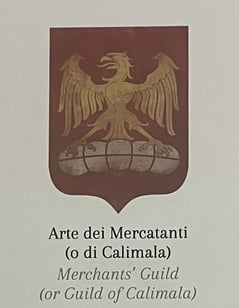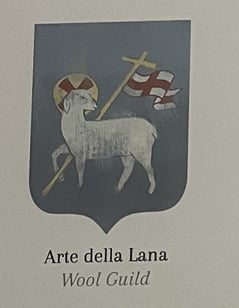FREE HOLIDAY GIFT WITH PURCHASE THROUGHOUT JUNE - SEE BOOKS FOR DETAILS
Clothing Production in Medieval Florence
A booming wool economy
ITALIAN RESEARCH
7/8/20242 min read


Yesterday in Instagram, I read aloud a description of Guidaloste, the medieval main character in The Power of the Wouivre, seeing the Arno River for the first time as he came down the hill from nearby San Miniato al Monte (you'll find my IG link at the bottom of this page if you want to read/ hear this description). In the thirteenth century, wool was a booming trade in Florence and accounted for much of the city's wealth. The town was unusual to other European communities of the time, in that it was a city of merchants rather than a feudal society. The Commune was divided into Guilds. The first recorded Guild was the Calimala. This was the Merchants' Guild and predominantly concerned itself with the wool production trade. Merchants would travel to the Fayre of Champagne in Troye and buy and import woollen cloth from Flanders to Florence where they would clean it, dye it and prepare it for resale to be made into woollen clothes. Their greatest competitors were the Wool Guild who, dealing with local wool, rather than imported cloth, managed the whole process from raw baled wool to finished cloth.
The process of cleaning and felting the wool ready for wear was known as "fulling". By the Middle Ages, this was largely done in water mills, powered by great water wheels. The unfinished cloth was cleaned to remove animal fats and grease. This was often done by soaking the wool pelts in vats of human urine - the staler the better! Once the cloth was de-greased, it was pounded, whilst still wet, with hundreds of little hammers inside the mill, to shrink the fabric and lock the fibres together which made the fabric thicker, stronger, warmer and more waterproof. If the fabric started to dry out, more urine was added. The difference between fulling and felting is that the latter works with loose fibres, whereas fulling involves woven cloth. The end result, however, is much the same. Once the fulling process was complete - and it took several hours - the cloth would be rinsed thoroughly and then moved to a tenterground and stretched out on tenters to dry out. This is where we get the expression "on tenterhooks" as the fabric was attached to the tenters with tenterhooks! The newly fulled fabric would then be brushed to raise the nap which would be sheared to create a softer, more wearable fabric. The final stage was for the fabric to be dyed, cut and turned into clothing. Dyes were gleaned from natural sources - plants, animals, rocks etc - so earthy colours tended to be more affordable than rich blues and bright, vibrant reds and explains why only the rich wore brightly coloured garments! This same is true for medieval art colours too but that can be reserved for another time!
This is obviously a very simplified description of the whole process but goes some way to show what the banks of the River Arno in Florence would have looked, sounded and smelt like in the thirteenth century!



